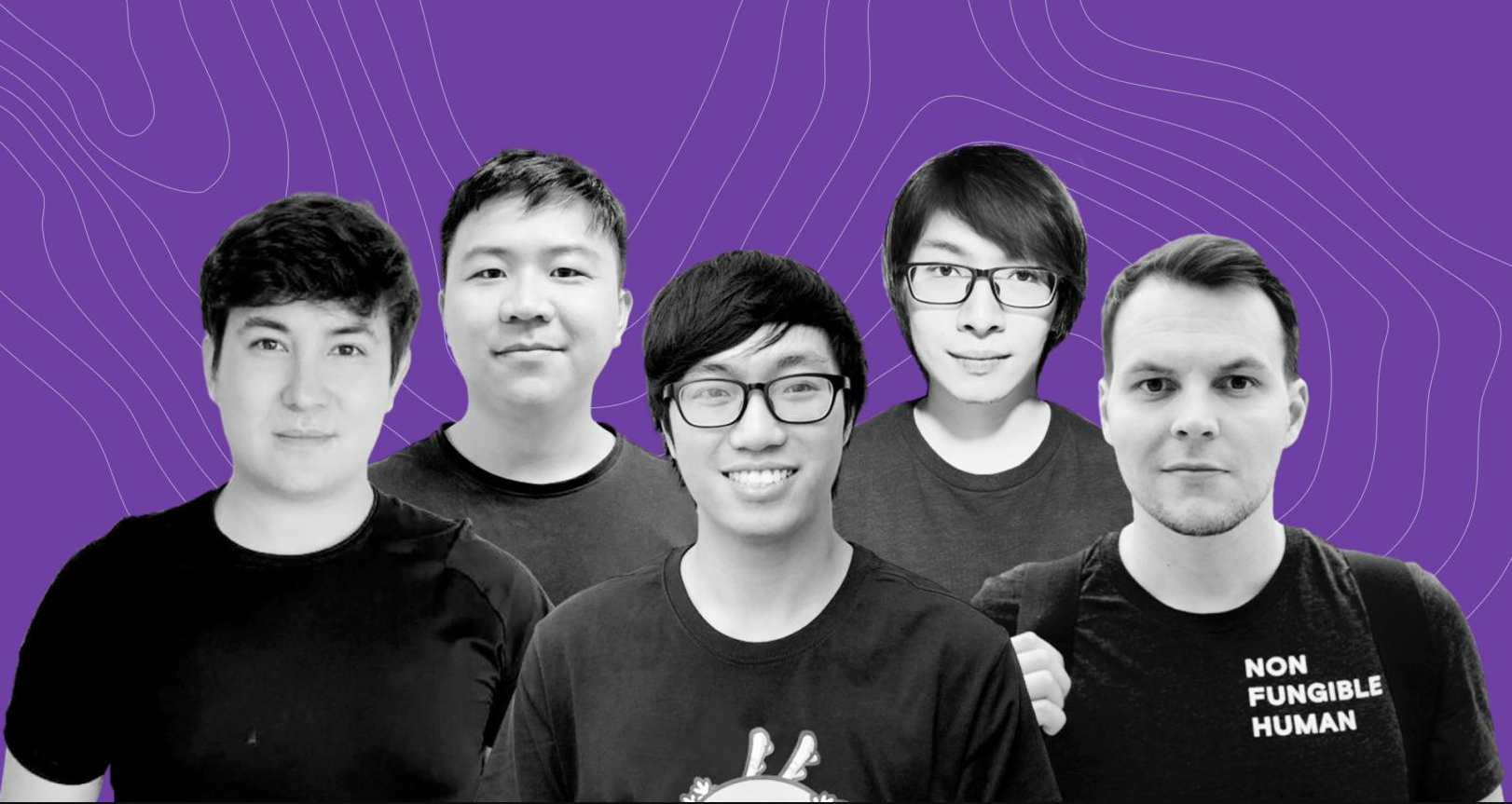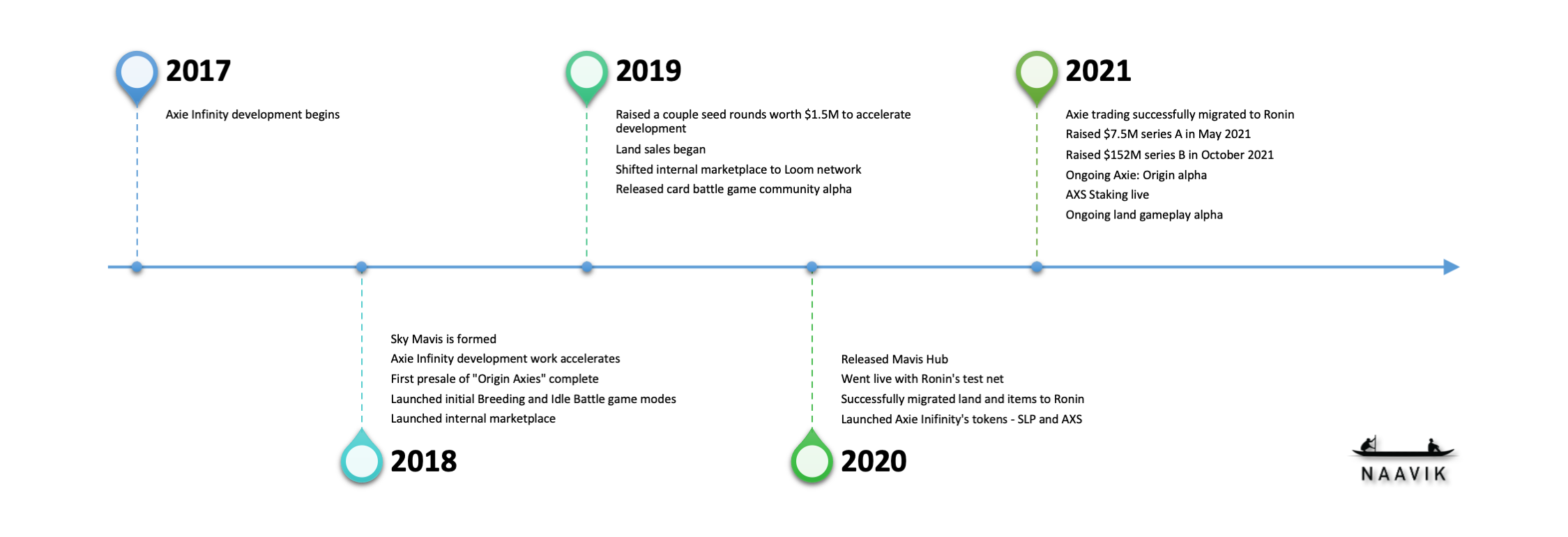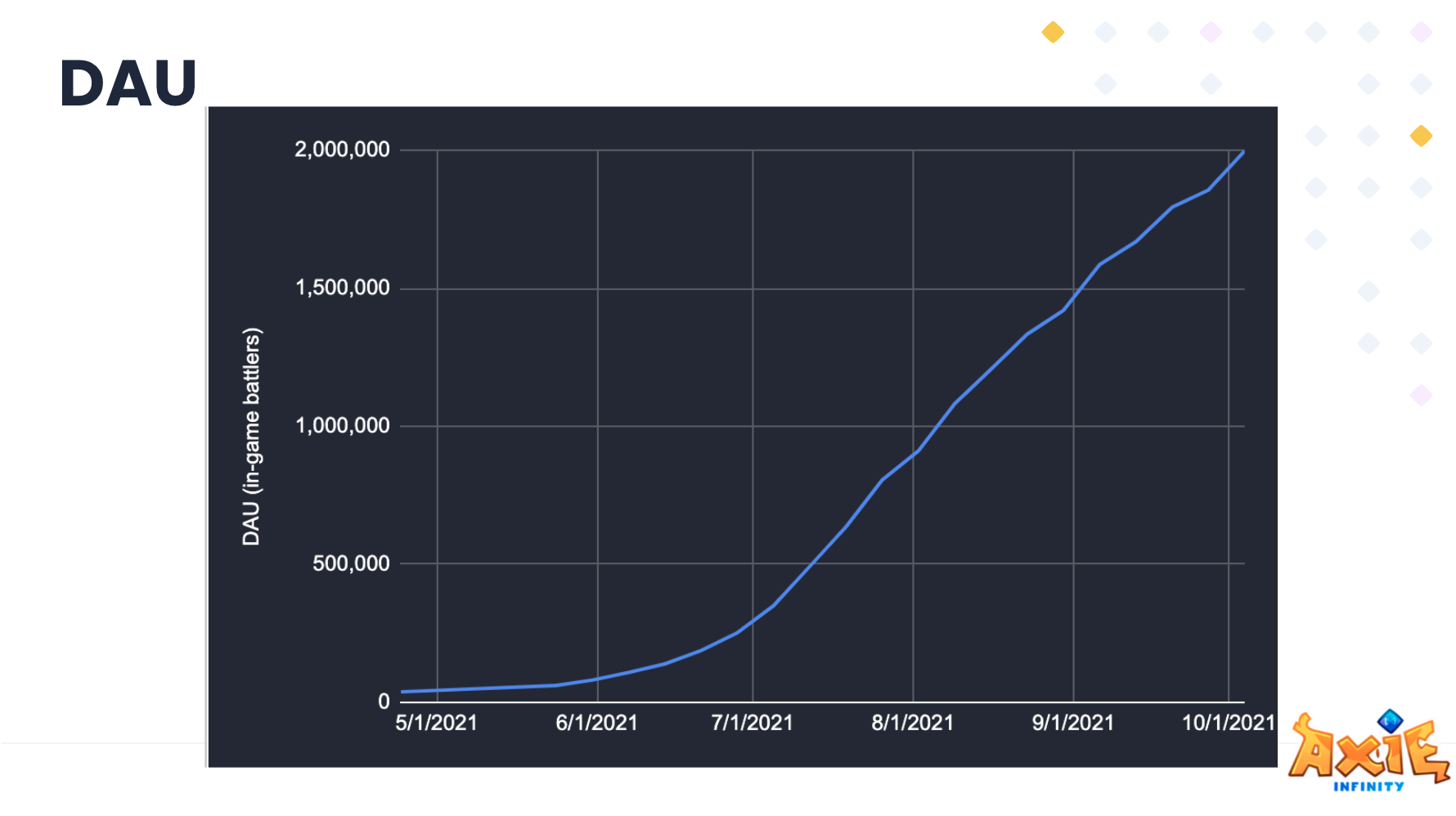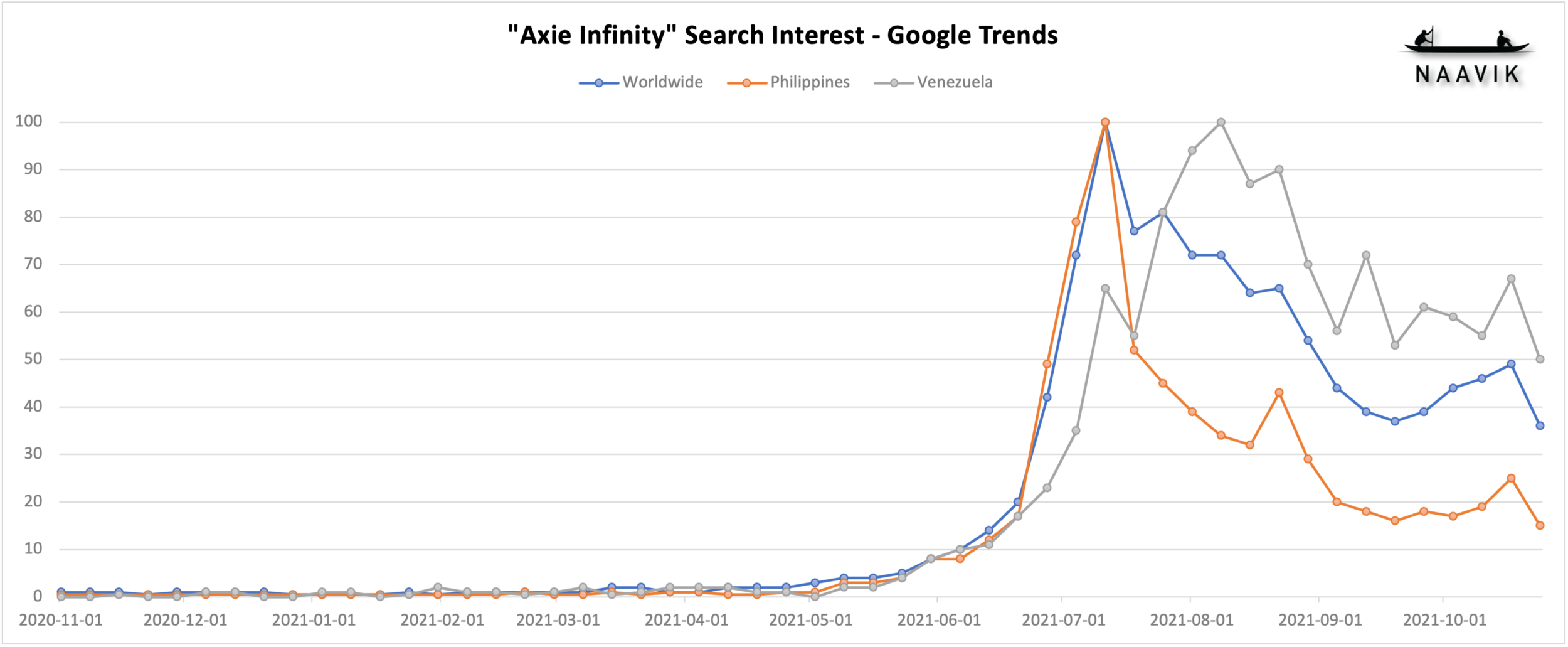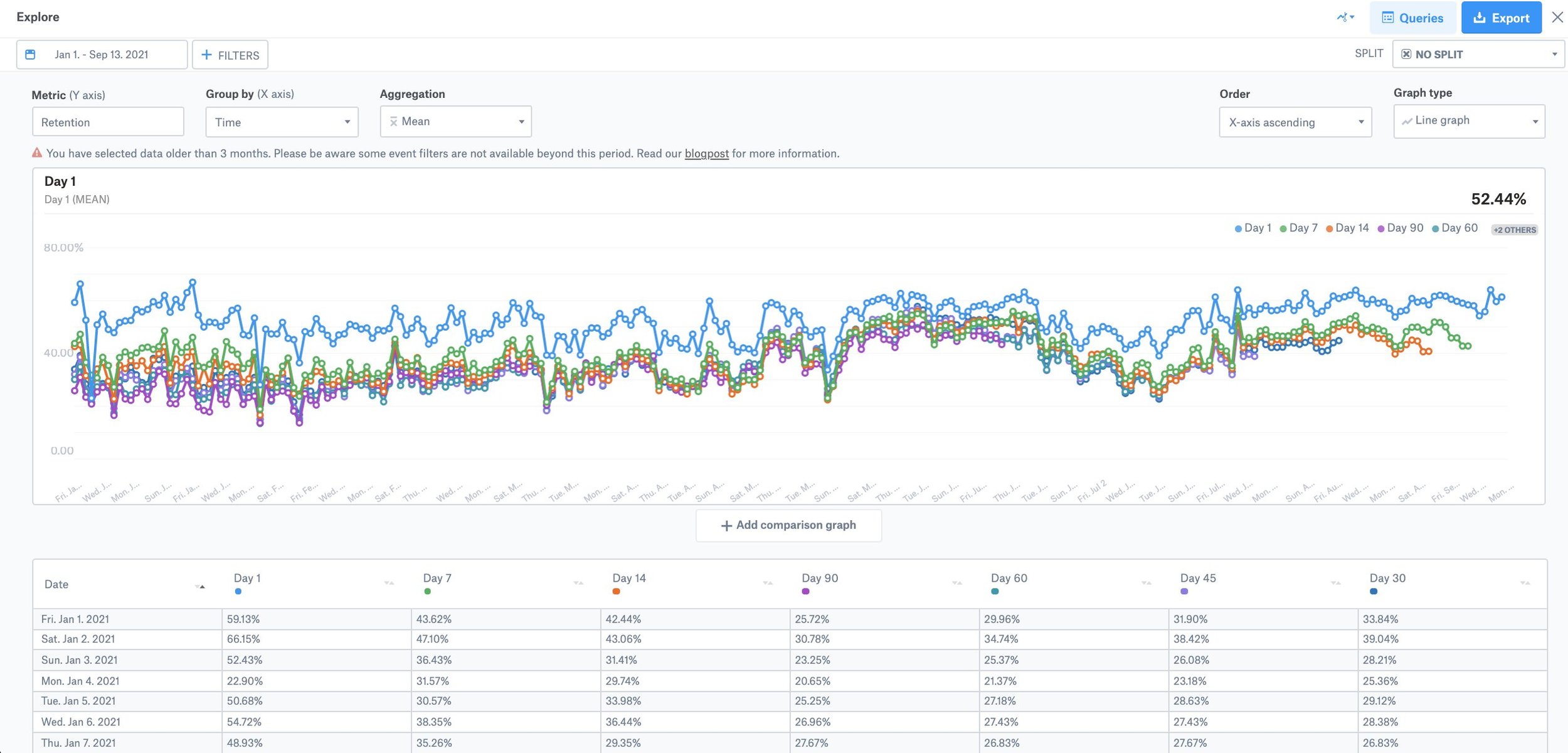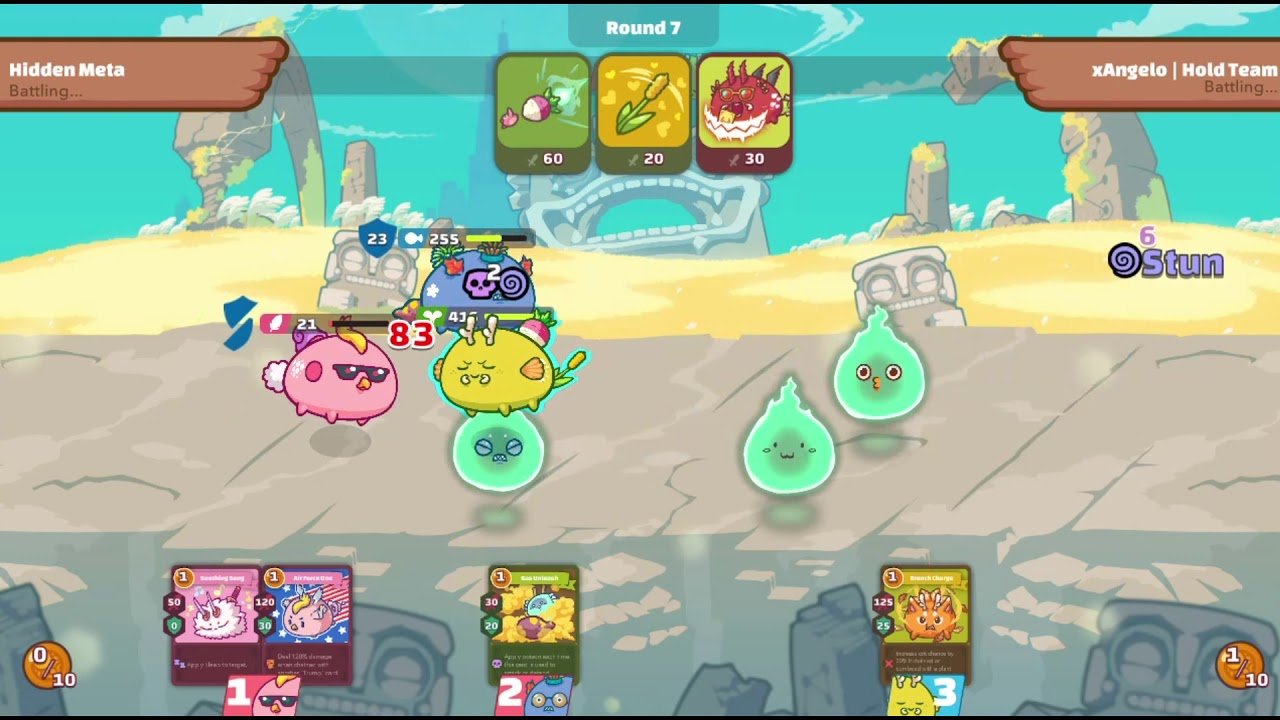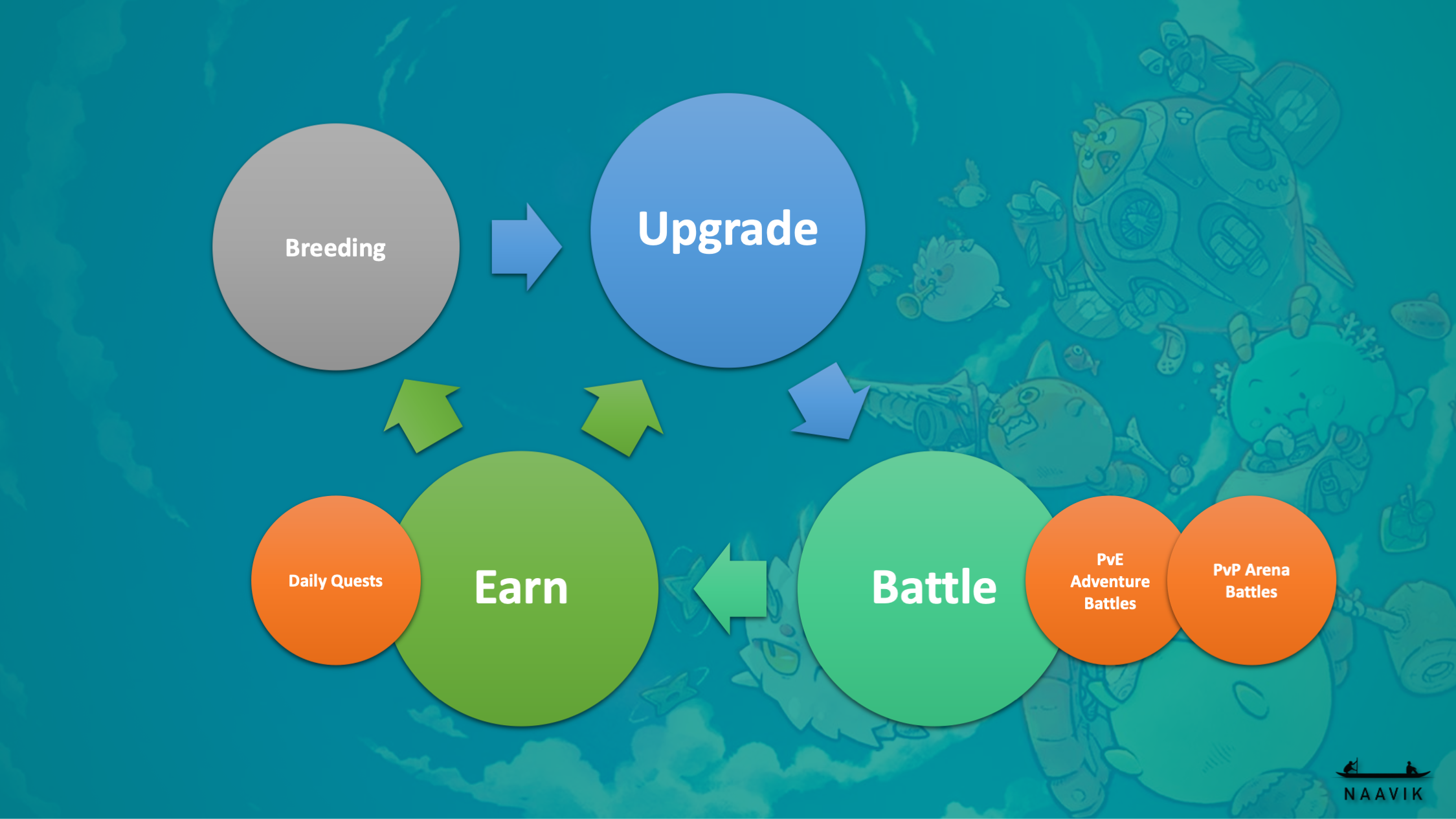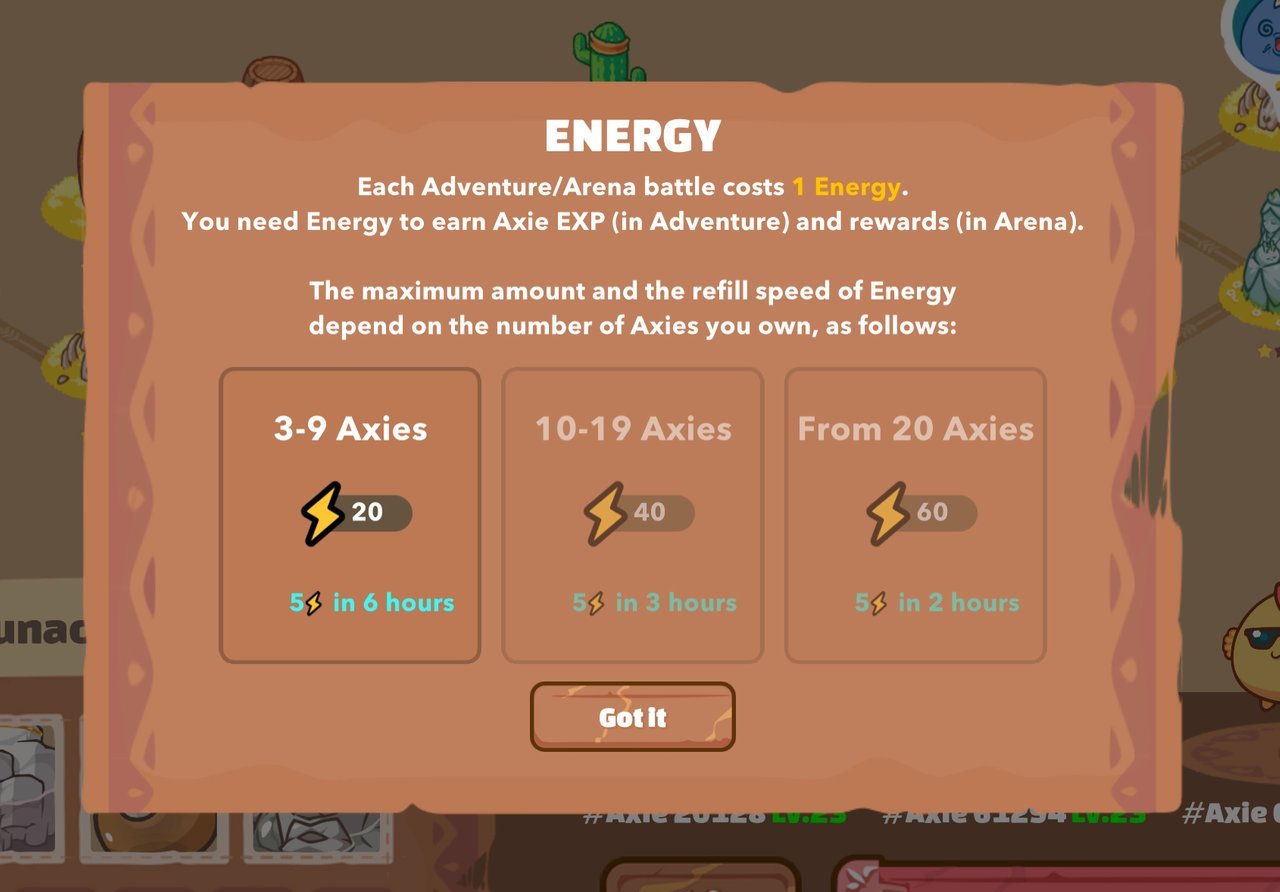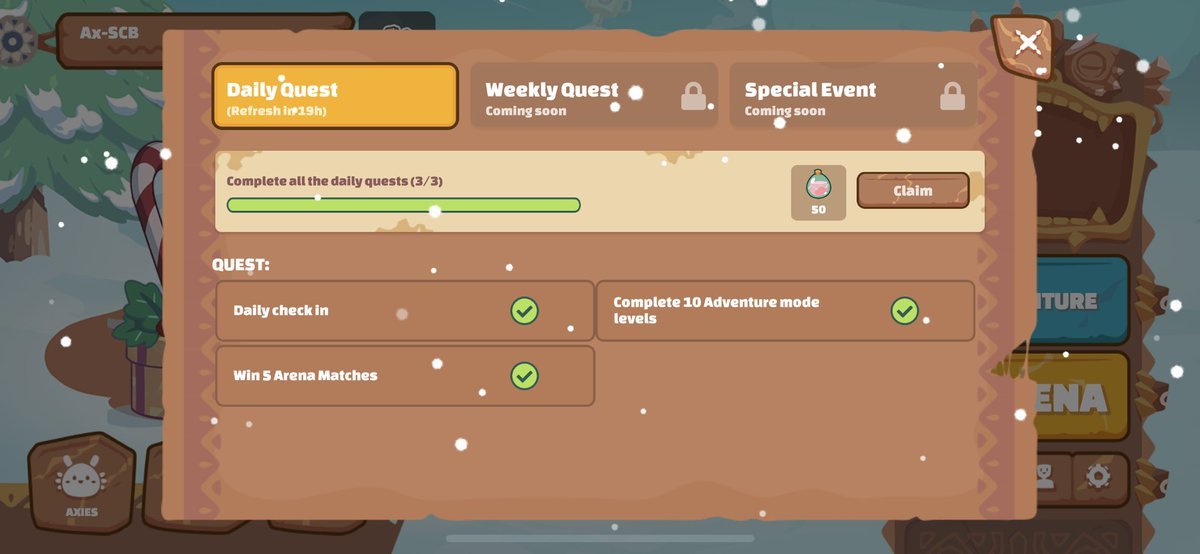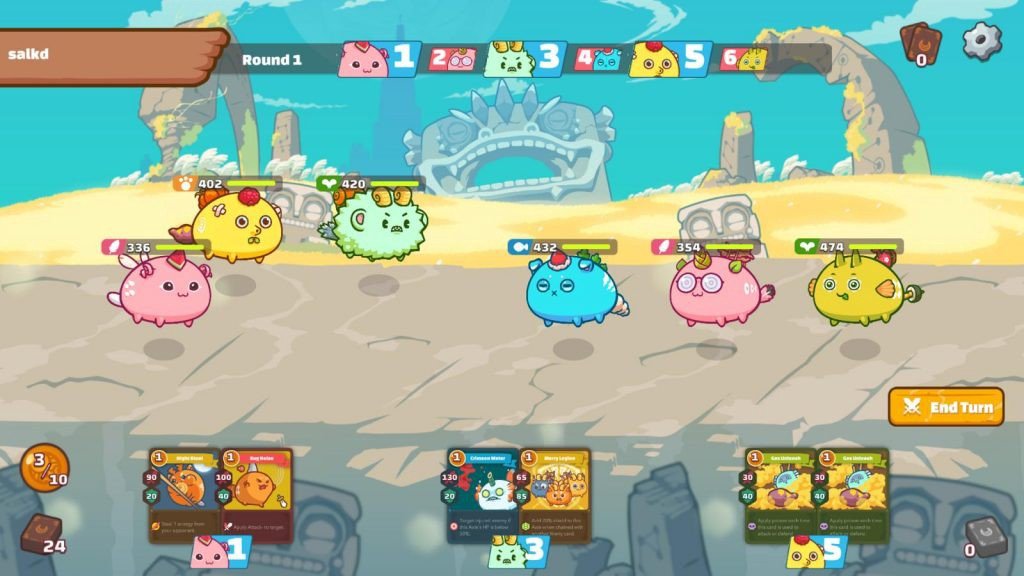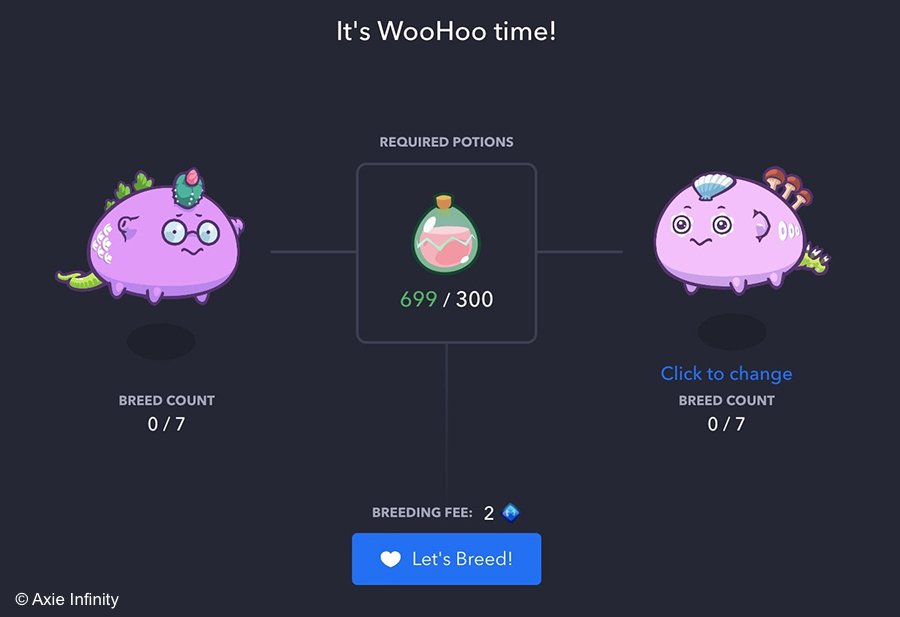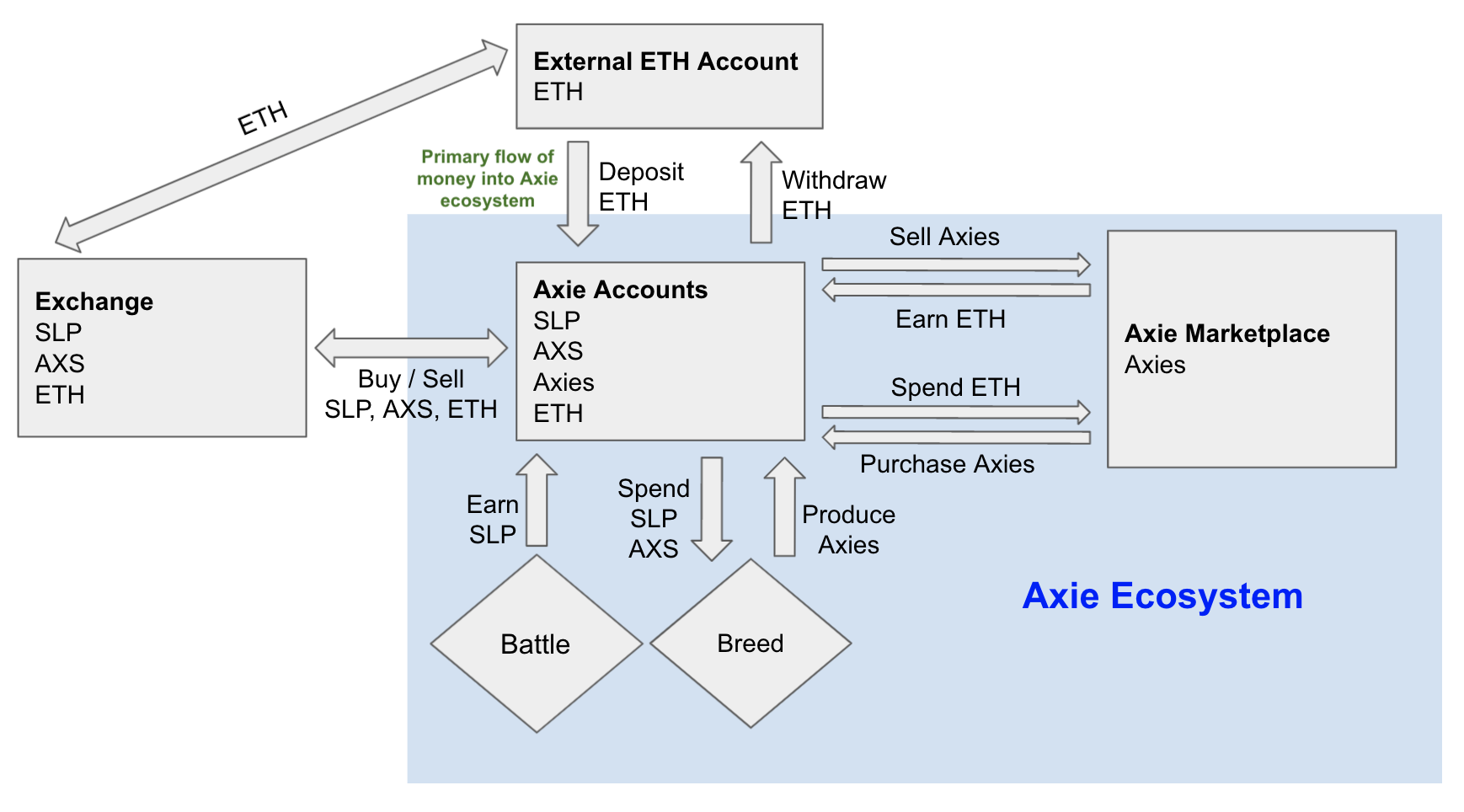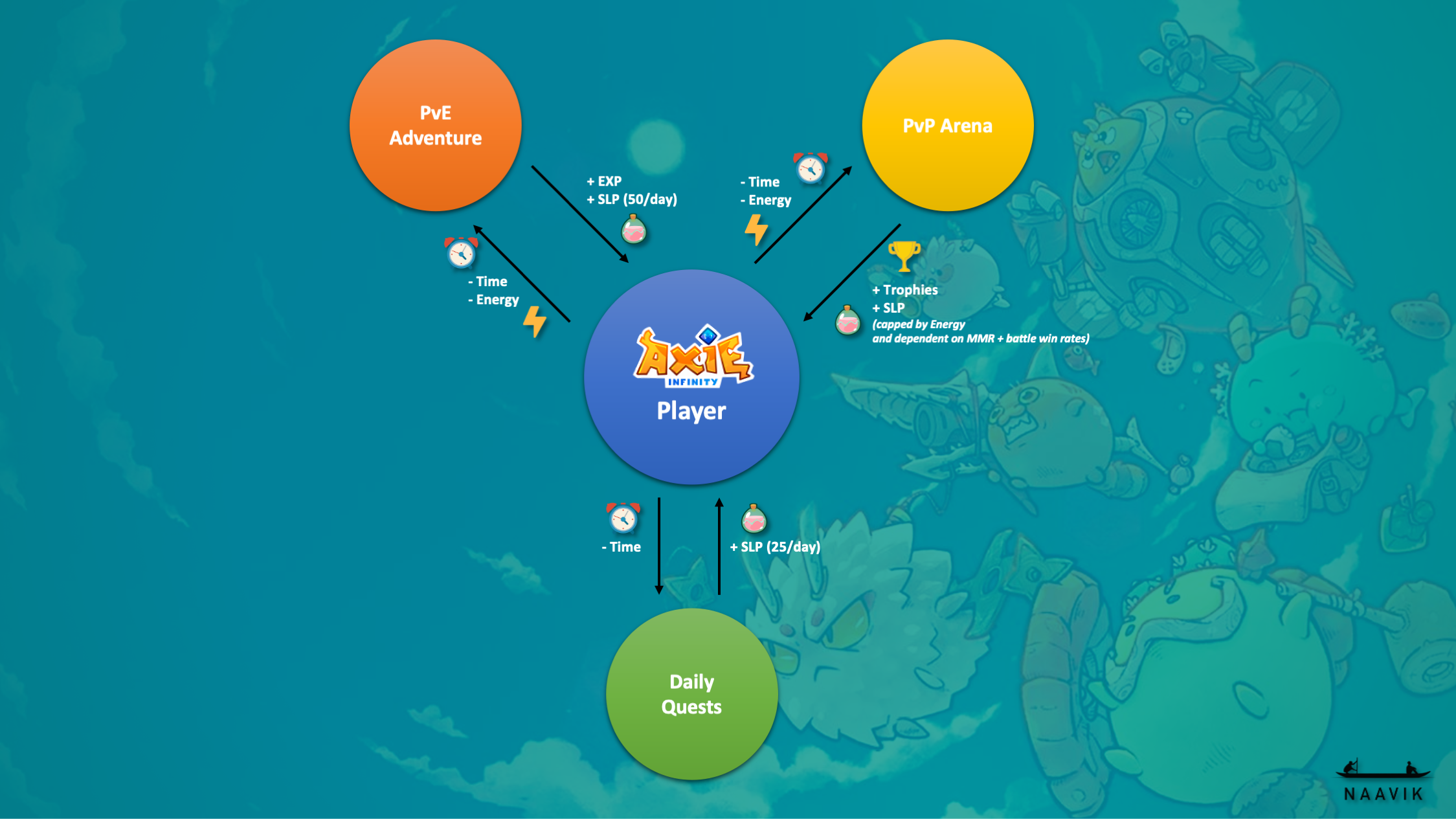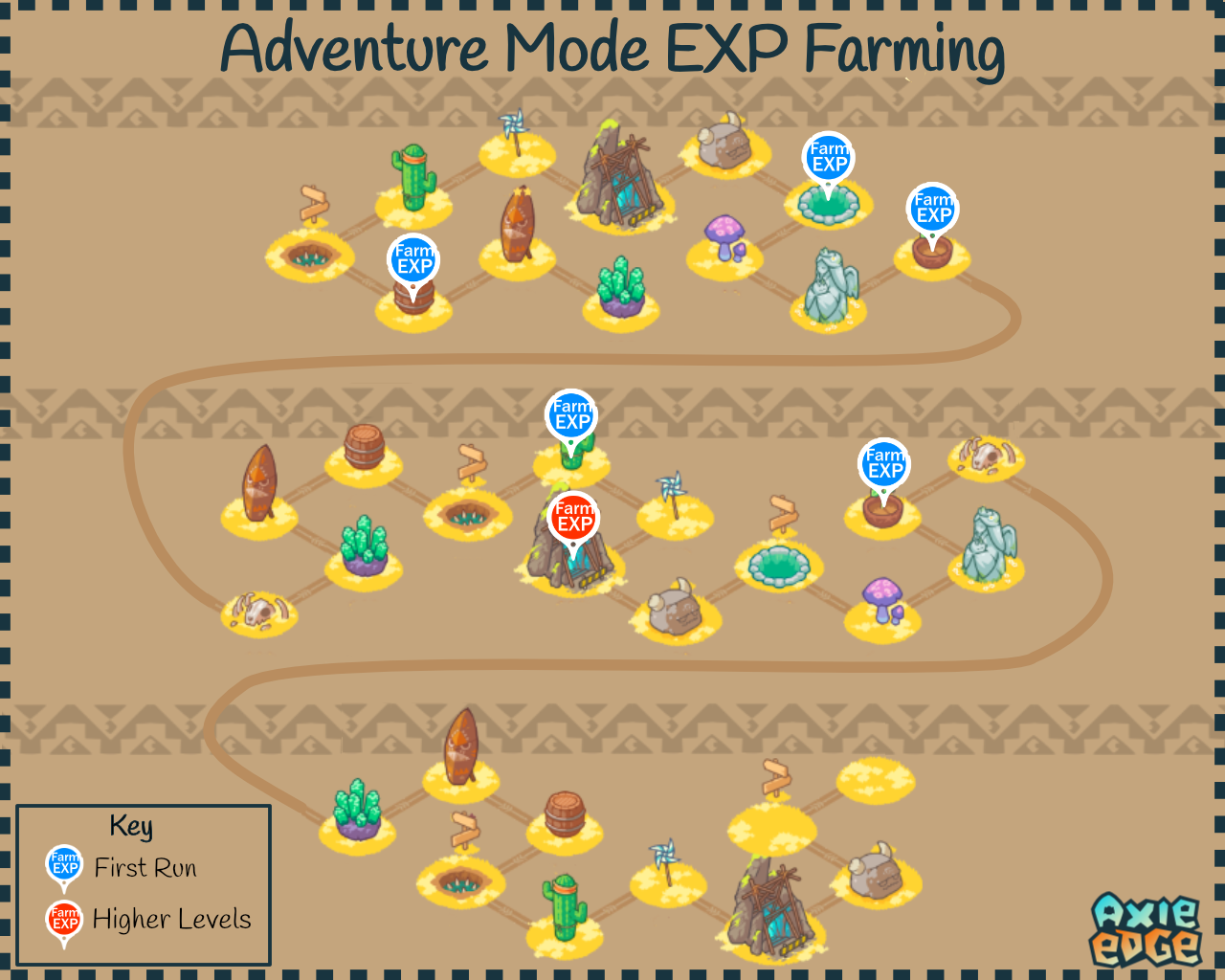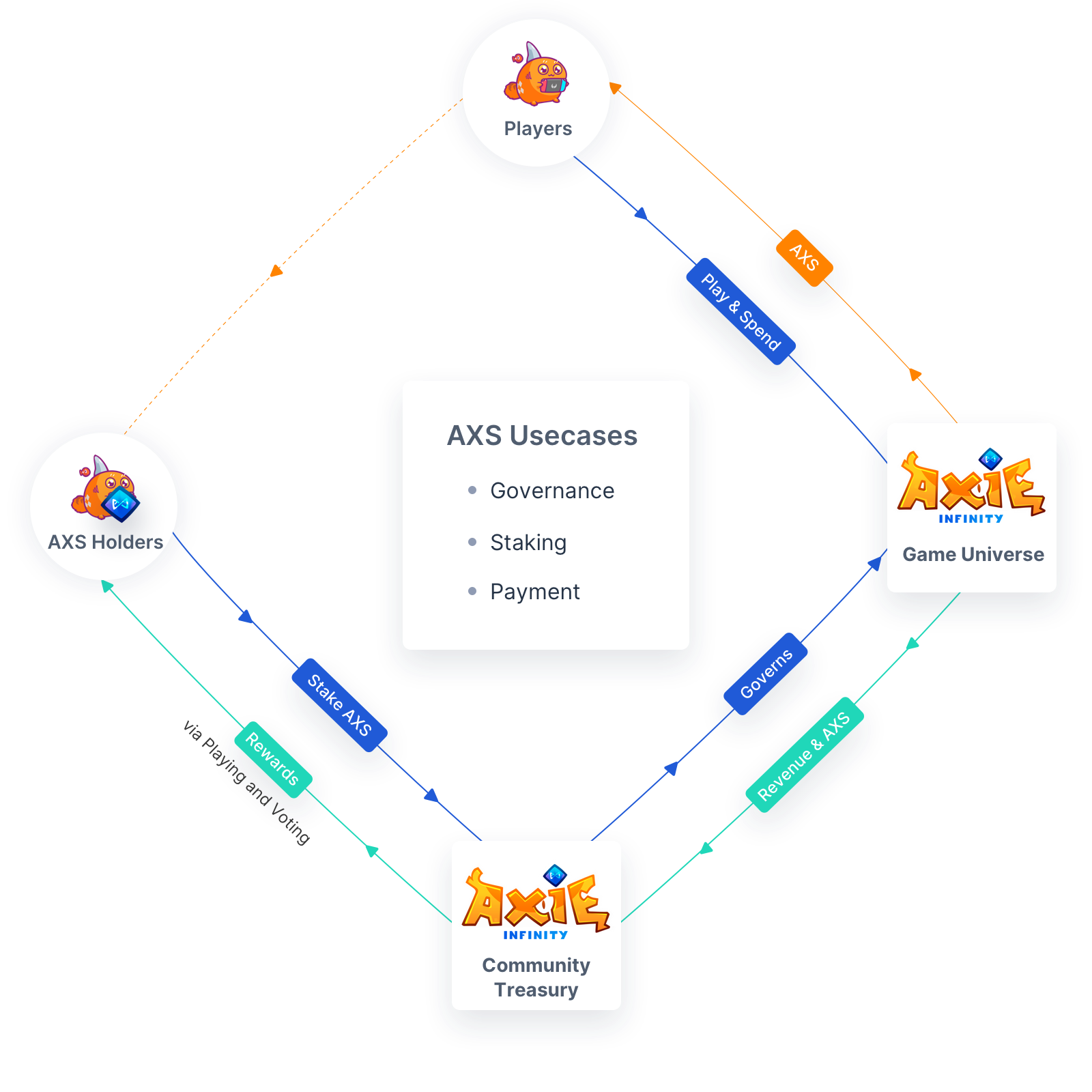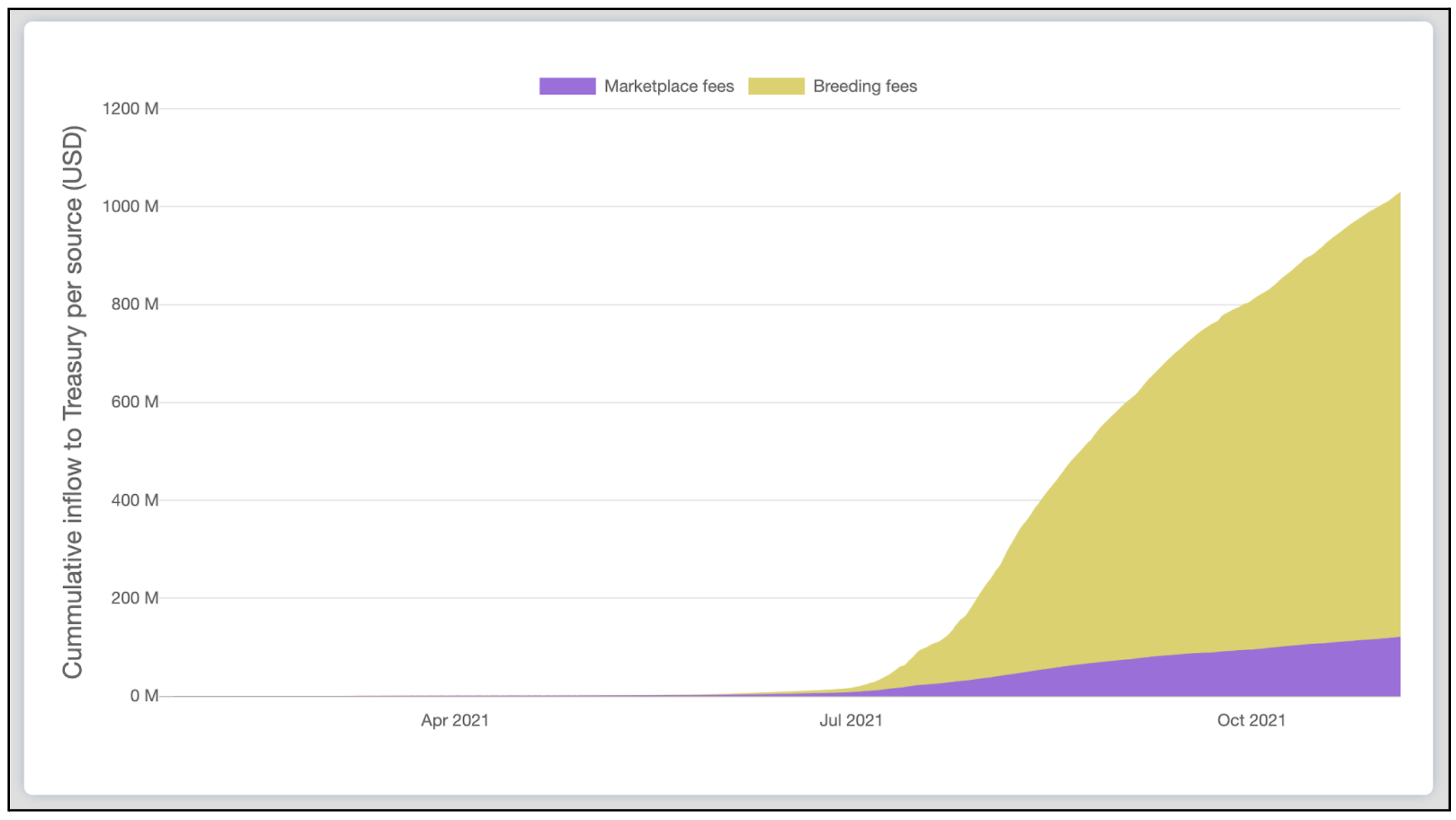Axie Infinity: Infinite Opportunity or Infinite Peril?
This deconstruction is done by our friends at Naavik. If you like it, you will love Naavik’s monthly Blockchain Games report!
Use code “NAAVIKDOF” at checkout and you’ll receive a -10% discount for the first subscription year.
This report was written by Jimmy Stone, Lars Doucet, Anthony Pecorella, Aaron Bush, Abhimanyu Kumar, from left to right.
Executive Summary
Sky Mavis’ mission is far more about spurring economic opportunity through play rather than about building an amazing game. That means players engage more as a job (often as “scholars” from developing countries who borrow in-game assets from richer “sponsors” or “managers,” who receive a cut of their earnings) than for fun.
That said, the progress the team has made with Axie Infinity over the past 3 years is impressive. 2021 was the true breakout year, but much of the technical and developmental foundation was laid prior.
The game’s basic design is fairly straightforward and simple, but there are concerns with the sustainability of its economic model.
The tokenomic element is still playing out. SLP, the in-game currency earned by winning and used for breeding additional Axies, has faced inflationary concerns, and Sky Mavis continues to tweak how much players earn. AXS, the governance token that represents future ownership of the game, is used for breeding, staking (although not for validating anything), and in the future will be connected to land. Additionally, the supply of Axies seems fine today, but since there aren’t yet ways to “burn” them, we may face an oversupply issue one day unless policies change.
The current game could continue to grow for a while, but its current economic policies are fundamentally unsustainable. The value of new Axies and SLP is propped up by new players putting fresh money into the game. If new player growth diminishes, it could send Axie Infinity into a recession.
Additionally, Axie Infinity has a recurring revenue problem, which threatens the value of the AXS tokens unless resolved. We project that even if DAUs steadily grow, if the pace of new monthly DAU declines then total monthly revenues may also decline (unless the team enacts broader changes).
The Sky Mavis team knows all this, which is why there are several new developments in the pipeline: a F2P version with (potentially) greater distribution, land, user-generated content, and more. Essentially, the goal is to build an Axie Infinity Universe with more ways to earn and spend tokens (and therefore generate more ongoing revenue). We are intrigued but still have specific concerns. Some concerns are easier to solve than others.
Sky Mavis’ vision is larger than Axie Infinity. It’s possible that the company turns Mavis Hub into a web3 Steam competitor, and Ronin, its Ethereum-based sidechain (and soon decentralized exchange), may eventually support other third-party games too. Given the massive Series B funding of late, the team definitely has the resources to take on these big opportunities, but the quality of execution is still TBD. Additionally, if they can’t first solve the economic challenges in Axie Infinity, these larger ambitions may be put in jeopardy.
Introduction
By now, most everyone has heard of Axie Infinity, the current flag-bearer of the emerging play-to-earn (P2E) business model. From the whitepaper: “Axie Infinity is a Pokémon-inspired universe where anyone can earn tokens through skilled gameplay and contributions to the ecosystem. Players can battle, collect, raise, and build a land-based kingdom for their pets.”
You may have seen a bunch of wild stats but have questions about where everything — Axie Infinity specifically and blockchain games more broadly — is headed. After all, most games don’t create documentary-worthy income-generating opportunities like Axie Infinity does in Southeast Asia.
Most games aren’t supported by burgeoning yield-generating scholarship programs that provide thousands of players access to scarce NFTs. Further, most blockchain games don’t earn revenue at levels that compete with the biggest and best crypto projects. Also, the vast majority of games (of any type) never see day-90 player retention stay nearly identical to day-30 player retention, even among their golden cohorts.
Source: Token Terminal
Finally — and despite being an unfair apples-to-oranges comparison — most games don’t capture value in their governance tokens that rival the market caps of some of the world’s biggest gaming companies. As you can see in the chart below, the fully diluted value of Axie Infinity’s AXS tokens rival the largest publishers in size and on a non-diluted basis is about as large as Zynga. Yes, there are caveats, and, yes, we can (and will!) criticize whether it’s reasonable or unreasonable, but Axie Infinity is showing the industry that value can be created and captured at scale in an entirely new way.
Source: Messari
How is all this possible? How do the game, economy, and tokenomics fundamentally work? Is there a catch, and, if so, what is it? Is Axie Infinity sustainable, will true decentralization occur, and how must the project evolve if it hopes to continue its long-term growth trajectory? What are the potential pitfalls, and what type of value creation is possible if the pitfalls can be avoided? These are the questions this report attempts to answer. However, before we dive deep into the present and future states of Axie Infinity, let’s take a step back to better understand how we got here.
The Genesis and Rise of Sky Mavis
Axie Infinity is developed by a studio called Sky Mavis, which is headquartered in Ho Chi Minh City, Vietnam, and officially formed in 2018 to bring the game to life. The initial three founders came together after realizing that existing crypto games — notably CryptoKitties at the time — were unsustainable both technologically and economically. However, they believed there was a superior path, and the founding team eventually grew to five:
Aleksander Leonard Larsen — the current COO with a background in esports; he’s also a board member of the Blockchain Game Alliance
Andy Ho — the current CTO with a background in software development
Jeffrey Zirlin — the current growth lead; he also spearheads community development and token design
Trung Nguyen — the current CEO with a background as a successful e-commerce entrepreneur in Vietnam
Tu Doan — the art director and lead of many game design concepts; he has a background in entrepreneurship and design
(From left to right): Jeffrey Zirlin, Andy Ho, Trung Nguyen, Tu Doan, Aleksander Leonard Larsen | Source: Sky Mavis
Of course, given the project’s meteoric ascent, the team has now grown to 80 employees. What’s notable about Sky Mavis is that even though it clearly aims to develop a great game, that’s not its guiding mission. The team’s mission is to “introduce the magic of blockchain technology to billions of players,” while “believing in a future where work and play become one… [and] in empowering players and giving them economic opportunities.” This unique lens helps explain Sky Mavis’ roadmap (within and beyond Axie Infinity), which we’ll dig into later. It’s also worth remembering that Axie Infinity isn’t just “a game” but an emerging ecosystem of different modes and Axie-driven experiences.
Image: Key milestones and events in Sky Mavis’ roadmap
The team technically began development in 2017, but work started accelerating with the formation of Sky Mavis in 2018. That year, the team completed its first presale of scarce “Origin Axies,” launched the initial breeding and idle battle game modes, and released the internal marketplace. The original gameplay essentially had zero imagery, and battle results were calculated through a text-based UI, so the game has come a long way in a rather short period of time. Here is an image of what Axie Infinity looked like in February 2018.
Source: Axie Infinity Newsletter
In 2019, after experiencing initial traction, the team decided to raise a couple seed rounds worth a collective $1.5 million in order to accelerate development. Investors like Delphi Digital, Animoca Brands, and Consensys took part in these rounds. Also in 2019, land sales began (an extension of the Axie Universe, which we’ll break apart in a later section), the marketplace shifted over to the Loom Network (a Layer 2 on Ethereum), and the card battle game community alpha released. In general, it was still a year of laying the foundation for future user growth and engagement.
2020 is when things started getting interesting in three key ways:
Sky Mavis released Mavis Hub, the PC launcher that serves as the central hub for new Axie Infinity updates as well as new games in the Axie Infinity universe.
Ronin — “an Ethereum-linked sidechain made specifically for Axie Infinity” — saw its test net go live. It helps transactions run faster and with lower fees compared to when the game ran on the main Ethereum chain.
Specifically, in 2020 land and items successfully migrated over to Ronin.
Between owning Mavis Hub and Ronin, Sky Mavis officially laid ground for important infrastructure that serves Axie Infinity but also Sky Mavis’ broader ambitions.
These additions made the Axie Infinity ecosystem far more robust and ready for scale.
Axie Infinity’s tokens also launched in 2020. Smooth Love Potion (SLP), the in-game currency earned by winning and used for breeding additional Axies, launched in mid-2020, and Axie Infinity Shards (AXS), the governance token where the most value accrues, launched later in the year.
That brings us to 2021 — Axie Infinity’s and Sky Mavis’ true breakout year! The largest inflection point hit right after Axies successfully migrated to Ronin, which made it economically viable and rewarding to buy, sell, and trade the game’s core NFTs. The migration to Ronin ended on April 28th, and you can see a clear exponential rise in the value of both AXS (and SLP) shortly after.
Source: Messari
The migration of assets to Ronin reduced friction, but it’s important to note that Axies in particular are the principal way that new players enter the game. Given that players must own three Axies to play at all, making them easier to buy and sell led to a spike in new users (and therefore also the demand for Axies and tokens). This new user growth was (and remains) mostly scholarship driven, and the game has now surpassed 2 million daily active users.
Source: Axie Infinity Newsletter
This acceleration of traction paired with the infrastructural foundation laid over the past couple years culminated in some mega-fundraising. Sky Mavis raised a $7.5 million Series A in May 2021, led by Libertus Capital. A $152 million Series B quickly followed in October, led by Andreesen Horowitz with participation from others like Mark Cuban, Accel, Konvoy, and Paradigm. Sky Mavis was valued at $3B; keep in mind that Sky Mavis owns 21% of the fully diluted AXS token supply, which once fully unlocked will be worth over $7 billion based on prices at the time of this writing.
There is more going on in 2021 — the Axie: Origin alpha (free-to-play), AXS staking, the land gameplay alpha (all of which we’ll dig into) — but the Series B clearly exhibits the scope at which Sky Mavis is increasingly thinking. Axie Infinity still has room to improve and attract new users, of course (it’s still not on mobile, doesn’t yet support user-generated content, and no decentralized governance is in effect yet), but attracting other developers and games to Ronin and Mavis Hub (essentially being a more broadly viable layer 2 and web3 Steam competitor) is now a key component to the Sky Mavis story.
Sky Mavis has moved quickly and rapidly unlocked tremendous value for players and token holders around the globe. It’s impressive and its status as a pioneer should be respected, but let’s now take stock of the current state of the game, dig into the details of what’s next, and then we’ll share our outlook.
Analysing Axie Infinity’s Users
As with any game, Axie Infinity’s market performance can be measured by looking at Users and Revenue. Let’s start with Users and try to understand three key things:
How many users currently exist?
Who are these users?
How do these users retain?
As mentioned previously -- and as you saw in the chart from the previous section -- Axie Infinity’s DAUs have skyrocketed ever since the Ronin migration occurred. According to Sky Mavis’ last update on the topic, DAUs are slightly north of 2M. Month-to-month growth looks approximately like this:
This month-over-month DAU growth trend shows that Axie Infinity’s growth spurt is somewhat decelerating, but a deceleration following such an impressive burst of growth is to be expected. Deceleration is also supported by the following Google Trends graph in the Philippines and Venezuela (the game’s top 2 countries), as well as worldwide in general.
Source: Google Trends
To find out where these users are located, we reached out to Sky Mavis COO and co-founder Aleksander Larsen. He told us that about 55% of their players are from the Philippines, and that more generally 65-70% of the overall population is from the entire Southeast Asia region. America is about 10%, and the remaining 20-25% is from Europe and Africa.
This comports with our best external source at the moment - Google Trends results over the past 12 months (Oct 2020-2021). As seen in the image below, the top five regions are generally low daily wage regions, with the exception of Singapore, which neighbors Vietnam, where Sky Mavis is headquartered.
Source: Google Trends
Given the potential to earn real money through playing Axie Infinity, the concentration of users in low daily wage regions makes sense. This primary motivation to play can be partially backed up by a May 2021 Twitter poll that Sky Mavis co-founder Jeffrey Zirlin conducted. When asked what their favorite thing is about Axie Infinity, nearly half of the respondents voted for “The Economy,” with a mere 15% putting gameplay first.
We asked Larsen if Sky Mavis had an internal figure for the % of players who are scholars, and he told us the following: “We are tracking these metrics. We’re trying to look at how many people are actively buying from the marketplace versus how many people are holding Axies? … Right now there are about 2,350,000 people who own Axies… somewhere between 60% and 65% are scholars, I would estimate.”
Another thing to consider is the game’s current entry cost. The minimum cost to enter the game right now is ~$350, while the average monthly salary (in 2020) in the Philippines was ~$892. In other words, a Filipino would need to fork over ~40% of an average monthly salary at today’s Axie prices to just start playing the game (and this is after a significant price drop in Axies!). Furthermore, the game’s terms of service forbid a single player from using multiple accounts simultaneously. Therefore, the only licit way for a money-rich player to put their virtual livestock of Axies to productive use, besides playing themselves, is to become Sponsors and lend out their Axies to time-rich Scholars. Hence, it’s entirely believable that the majority of players in developing nations are scholars.
Axie Infinity players typically come from low income regions. They are primarily scholars whose foremost motivation is to earn money. It’s easy, therefore, to understand why the D90 retention rate closely mimics the D30 retention rate of 25-30% (as seen in the image below). We’re basically looking at the retention rate of a job, not a game! This isn’t necessarily a bad thing — and it’s consistent with Sky Mavis’ mission — but it means we must look at Axie Infinity through a slightly different lens compared to other games.
It’s possible that as long as Axie Infinity enables its scholar-dominated player base to earn more income than they would doing normal jobs in their home countries, long-term retention and DAU growth will continue to remain healthy. We will revisit this hypothesis when analyzing SLP later in the report.
All in all, Axie Infinity’s growth spurt is decelerating (although still positive), and a majority of its player base treats the game like a daily job to make daily financial ends meet.
Next up, let’s take a look at the game design fundamentals, which will then help us understand how the tokens come into play and better understand the sustainability of Axie Infinity’s revenue generation.
Game Loops and Systems Overview
Axie Infinity’s game design falls under the “Turn-based RPG” subgenre, according toGameRefinery’s taxonomy. That means its core loop is a simple battle-upgrade loop but with an additional “earn” component.
Image: Axie Infinity core loop
The core battle experience is more engaging than typical free-to-play (F2P) turn-based RPGs, which usually design their core gameplays from an autoplay-first perspective. This is because typical F2P turn-based RPGs usually want their players to end up spending more time with the money-making meta gameplay systems versus worrying too much about decision making in the core gameplay systems.
On the other hand, Axie Infinity mashes familiar turn-based gameplay with a Hearthstone-like card battler mechanic. In a P2E context, this is a smart design decision for three reasons:
It enables a longer-term Player-vs-Player or PvP-based metagame, which results in no two battles ever being the same. That translates into keeping gameplay fresh for longer, while simultaneously taking the edge off of “earning feeling like a grind” and in-turn driving long-term retention.
It creates an esports-fertile product, since the core battle experience allows two players to have a fair battle that is highly dependent on skill versus stats.
It decreases botting risks when playing against real players, since active and reactionary decision making in response to how a battle develops is critical to ensuring a win. In other words, the core battle experience is not so easily “auto-playable.” Even though that does not entirely eliminate the risk of botting, it reduces it to a good extent.
All of this is rooted in the fact that having a card battler mechanic live in the core gameplay greatly increases the player skill ceiling, especially when playing against other players. Said simply, the card battler mechanic instantly contributes to making Axie Infinity an “easy to learn but hard to master” type of game.
Image: Axie Infinity core gameplay - turn-based RPG + card battler mechanic
When players begin the game, most of the battling occurs in the Player-vs-Environment (PvE) Adventure mode, and players focus on completing the Daily Quests. Over time, players slowly graduate towards the metagame, which is made up of the Player-vs-Player (PvP) Arena mode and Breeding. At the heart of all these systems is the Energy mechanic, and what connects all these systems together economically are the game’s two key token currencies, SLP and AXS. Therefore, there are a few key game systems that collectively result in the game’s current loop:
Energy mechanic
Daily Quests, PvE Adventure mode, PvP Arena mode
Breeding
SLP and AXS tokens
Image: Axie Infinity full game loop
#1: The Energy System
Axie Infinity Energy is a key engagement gating mechanism put in place to curb both Axie leveling up and SLP inflation due to economically exploitative player actions, such as excessive grinding and botting. As can be seen in the image below, the maximum amount of Energy a player can hold and its refill rate at any point in time is directly connected to the number of Axies the player owns:
3-9 Axies → 0.8 Energy / hour (20 Energy / day)
10-19 Axies → 1.7 Energy / hour (40 Energy / day)
20+ Axies → 2.5 Energy / hour (60 Energy / day)
Image: Axie Infinity Energy system design instructions
#2: Daily Quests:
As with any daily quest system, Axie Infinity’s Daily Quests consist of three tasks, which refresh every day at 12:00 GMT and deliver a value of 25 SLP on completion:
Complete the Daily Check-in (by logging into the game)
Complete 10 PvE Adventure mode levels (can be the same level each time)
Win 5 PvP Arena matches
Image: Daily Quests in Axie Infinity
#3: PvE Adventure Mode
Axie Infinity’s PvE Adventure mode is a simple turn-based card battler gameplay experience with saga-style progression (similar to that seen in games like Candy Crush) and preset PvE battles per level.
This mode consists of 36 levels with increasing difficulty. Players need to enter every level with a team of three Axies, battle the non-player characters (NPCs), and win to earn SLP. Currently, a player can earn a maximum of 50 SLP / day through this mode.
Images: (Left) Axie Infinity PvE Adventure mode stage 26 | (Right) Axie Infinity PvE Adventure mode gameplay screenshot
#4: PvP Arena Mode
Axie Infinity’s PvP Arena mode is for more experienced players, where they can battle other Axie Infinity players for more substantial SLP rewards on every win. The gameplay is no different to the PvE Adventure mode, just that the opponent is a real player with three Axies as the competition. Further, mastering one’s deck and playing each card tactically is quite important to guarantee a win in this mode, which greatly reduces the risk of botting and SLP farming.
Image: Axie Infinity PvP Arena gameplay screenshot
#5: Breeding
In Axie Infinity, it is possible to breed any two existing Axies to create (mint) a new Axie. Each Axie belongs to one of 9 classes (6 public + 3 secret classes) and has 6 body parts plus a body shape. Each body part possesses 3 genes — a dominant (D), recessive (R1), and minor recessive (R2) gene. Further, each of the 12 recessive genes (6 body parts * 2 recessive genes per body part) has a chance to mutate into a completely random part (not inherited from either parent). And finally, neither are parents allowed to breed with their offsprings nor are offsprings allowed to breed with each other. Long story short, the number of Axie combinations veers toward infinity!
Further, performing a breeding action costs AXS and SLP, the amount of which depends on how many times the Axie has been bred. In order to avoid hyperinflation of Axies, there is a maximum number of times an Axie can breed (7 times) before it is sterile. Axies with a breed count of 0 are also referred to as “virgin” Axies. If interested, you can read more here and here.
Image: Axie Infinity Breeding screen
Broadly, all the systems and game loops make sense on paper. However, to properly evaluate the efficacy of these systems in a P2E context, they need to be viewed in conjunction with the game’s tokenomics. At the end of the day, the tokenomics define how players gain monetary value from playing Axie Infinity, and the game design systems facilitate that value generation.
To evaluate Axie Infinity’s tokenomics, we need to understand the two tokens that run Axie Infinity’s economy: SLP (Smooth Love Potion) and AXS (Axie Infinity Shards). Below is a broad overview of how token value flows through Axie Infinity’s ecosystem. Let’s analyze each token one by one.
Source: Axie Pulse
Evaluating SLP’s Sustainability
Smooth Love Potion (SLP) is Axie Infinity’s key in-game digital currency. It is an ERC-20 token that can only be earned (Minted) by playing the Daily Quests, PvE Adventure, and PvP Arena modes in the game, and it is spent (Burned) by Breeding new Axies. Importantly, SLP does not have a hard cap to its total supply. SLP’s circulating supply is in constant flux, and its supply / demand heavily depends on the amount of in-game activity.
Additionally, SLP can also be traded on cryptocurrency exchanges (including on Katana - the new Ronin DEX), which enables wider market access. The external market for SLP emerged when a liquidity pool for ETH-to-SLP conversion was created on the Uniswap DEX. This is a noteworthy caveat because accruing ample SLP to perform in-game breeding actions can be a long grind for many. However, with a SLP secondary market in place, it is now possible to quickly accumulate the token without needing to spend as much time or effort to earn it via natural in-game methods. Said differently, while players can earn SLP by playing Axie Infinity, they can also purchase additional SLP from other players on exchanges to accelerate their in-game progress. That naturally makes balancing the SLP economy for long-term token sustainability even more important.
SLP’s Performance Until Now
At the highest level, SLP supply has seen a major surge since the start of 2021. This is not surprising given the massive influx of new players into Axie Infinity, which naturally resulted in greater generation of SLP in the economy. The real question to ask, though, is whether SLP is healthy as a digital currency? For starters, both SLP’s price continues to generally trend downwards, and the market cap is well off of its highs too.
Source: CoinGecko
To understand SLP’s price and market cap trends, we need to look at SLP’s minting and burning metrics. These are captured in the graph below, which surfaces a few key observations: 1) SLP Minted is generally hovering in the 100-200M/day range, 2) SLP Burned is generally hovering in the 50-100M/day range, 3) the SLP Mint / Burn ratio is currently ~2.5 and currently moving upwards.
Source: CoinGecko
In short, not only is there more SLP being generated by the system versus being sunk, but this trend is also slowly accelerating. In other words, the supply of SLP in Axie Infinity’s economic system continues to rise, which naturally pushes its market price down. This points to a SLP imbalance in the game, and if Axie Infinity does nothing, it’s only going to get worse.
SLP Supply = Mkt. Cap/Price OR Cumulative SLP Minted - Burned | Source: Axie World, CoinGecko
Looking at SLP’s supply curve (above), here are some observable trends:
Before June 2021, SLP’s supply gradually rose as more players started playing.
Between Jun-Aug 2021, SLP supply mostly flatlined as the rate of SLP burning caught up with the rate of SLP minting.
Between August and September 2021, SLP supply started skyrocketing. Both new and existing players started generating more SLP than usual, which led to a spike in supply and (predictably) a decline in SLP price as a result.
After September 2021, SLP supply basically goes exponential due to a major oversupply problem, which also confirms the previously stated SLP imbalance hypothesis. Notably, the SLP price has not recovered from its peaks of $0.30-0.35 and currently sits at $0.05-0.10.
All in all, the devaluation of SLP’s price due to an oversupply of SLP in the in-game economy is the biggest issue. This is why Sky Mavis has taken some very significant and highly directive steps in the recent past that directly impact the amount of the SLP that can be earned from the game across all types of players - one way to enact monetary policy. For a P2E economy, a devaluation of the key in-game currency means players now need to grind more than ever to generate the same amount of earnings per day as they would’ve when the prices were higher. Said differently, the SLP economy has an inflationary problem that needs to be fixed soon so that long-term player retention is not hampered and in-game income is less compelling to new users. To better understand what is causing the SLP inflation problem, it’s important to understand SLP’s economic design components first.
Analyzing SLP’s Sources
As mentioned before, there are three main sources and one sink of SLP in the game and each of them are tuned slightly differently to mint / burn certain amounts of SLP on a per action per player per day basis. At the root of SLP is “Energy,” so let’s understand its role first.
SLP Limiter: Axie Infinity Energy
As a quick refresher, Axie Infinity Energy is a key engagement gating mechanism put in place to curb both Axie leveling up and SLP inflation due to economically exploitative player actions, such as excessive grinding and botting. The way Energy curbs the leveling up of Axies and SLP inflation is connected to why it is required in the game:
In the PvE Adventure mode, Energy is required to gain EXP:
Using Energy to complete PvE Adventure mode levels generates EXP for individual Axies.
More EXP results in Axies leveling up.
Leveled up Axies help with beating higher PvE Adventure mode levels.
Higher PvE Adventure mode levels generate more SLP per win, but SLP minting through the PvE Adventure mode is capped at 50 SLP per day.
Leveled up Axies also help with moving up the arena brackets and (Match Making Rating) MMRs by winning more.
Higher MMRs reward more SLP per win, but this SLP minting is capped by Energy, as explained in the next bullet.
In the PvP Arena mode, Energy is required to gain SLP:
Starting a PvP Arena battle requires 1 Energy.
Since the PvP Arena mode has relatively larger SLP payouts per win versus the PvE Adventure mode, the Energy inventory cap helps with limiting the number of PvP Arena battles per day and therefore limiting SLP minting.
For example, players with 3-9 Axies will be able to perform a maximum of 40 battles per day and their SLP earnouts are further limited by their battle win rate and a variable amount of SLP rewards per PvP Arena bracket.
Daily Quest completion doesn’t directly require Energy, but it indirectly does for two of the three quests in the following way:
A player can complete the PvE Adventure mode quest by not using any Energy at all. But another strategy would be to use Energy to complete the quest, so that Axies level up simultaneously. That in turn helps with a high chance of winning PvP Arena battles.
Playing PvP Arena battles directly requires Energy, but winning 5 of them also completes the PvP Arena quest.
Image: Axie Infinity Energy to SLP generation relationship
Based on all that, it is clear why Energy lives at the core of SLP inflow into Axie Infinity. That also means it is the strongest lever in Sky Mavis’ hand to balance the SLP economy during times of token inflation / deflation. On the other hand, it is also the most risky lever to touch since it directly impacts in-game engagement metrics, or the amount of “fun” one can have with the game. As we will see next, this is likely why Sky Mavis hasn’t touched Energy tuning when trying to curb today’s inflationary nature of SLP, but has rather focused on improving the inflow / outflow tuning of various SLP sources and sinks.
SLP Source #1: Daily Quests
As mentioned, Axie Infinity’s Daily Quests consist of three tasks, which refresh every day at 12:00 GMT:
Complete the Daily Check-in (by logging into the game)
Complete 10 PvE Adventure mode levels (can be the same level each time)
Win 5 PvP Arena matches
While the first task clearly incentivizes daily retention, the other two are geared toward driving engagement with the two main game modes. Completion of all three quests will earn a player a fixed daily 25 SLP reward, which was nerfed from 50 SLP before Season 18 started on August 10th, 2021.
It is also interesting to note that Weekly Quests and Special Events are “Coming Soon,” which might prove to be additional sources of SLP and in-turn medium-to-long-term retention drivers. As the influx of new Axie Infinity players settles down, driving engagement of an established audience becomes increasingly important, which justifies the eventual introduction of these two new quest types.
SLP Source #2: PvE Adventures
To quickly recap, Axie Infinity’s PvE Adventure mode is a simple turn-based card battler gameplay experience with saga-style progression (similar to how Candy Crush has multiple levels on a saga map) and preset PvE battles per level. Players need to enter every level with a team of three Axies, battle the NPCs, and win in order to earn SLP. A player can earn a maximum of 50 SLP per day through this mode, though this too was nerfed from 100 SLP per day before Season 18 started on August 10th, 2021.
This mode consists of 36 levels with increasing difficulty. The higher the level, the more EXP rewarded, which helps level up Axies. The higher the Axie level, the more SLP is minted for the player. For example, Axie levels 1-4 generate 1 SLP/win, while Axie levels 21-36 generate 10-20 SLP/win. Further, there are also two Boss Fights at Levels 21 and 36, which give the player 200 and 300 one-time SLP rewards.
Since this mode only consists of 36 levels, it is almost required for the “Complete 10 PvE Adventure mode levels” Daily Quest to allow repetitive completion of the same level to trigger quest completion. In a way, this is not the most optimal design for a saga-style progression mode, which has proven to maximize long-term player retention by delivering continuous saga-map progression. Also, this design is also easily exploitable and thereby dangerous for SLP economy balance:
Fixed level designs are highly susceptible to botting.
Players could optimize their SLP earnings per day by playing lower levels and farming SLP.
Players could also optimize their EXP earned per Energy spent per day to level up Axies, move up the saga-map, farm higher SLP generating levels, and then generate higher EXP for every Energy used, which leaves more Energy to generate SLP within the PvP Arena mode.
Further, when looking at the EXP gained per PvE Adventure level curve (below), it is slightly confusing that the EXP amounts jump so much level to level. There are two ways to look at this:
The pessimistic view: Since there are only a small number of levels and difficulty is increasing with every level, ideally EXP gains should increase just a little bit with every level. This variable curve could devalue certain levels versus others in the players’ eyes, reduce the efficacy of a low number of levels in the whole mode, and more broadly create economy exploitative holes in the mode.
The optimistic view: There might be good reasons for this curve even when there are a small number of levels. For example, level 21 could be significantly harder than level 22, or take longer. Also, uneven curves allow for player optimization, which help players feel more like experts. It is possible that players view this as a series of tiers: they’d want to grind 12, 21, 26, or 30 - the highest one they can get to.
The most dominant view of the two is really defined by player perception, but it’s safe to say that Axie Infinity would like their PvP Arena to be the major long-term retention driver and have PvE Adventure purely enable that, which is why they don’t seem to be investing into creating too much content (levels) for it.
Image: Amount of EXP gained per win on every PvE Adventure level
One golden line of game design wisdom is “Players will find the loopholes,” and that is exactly what Axie Infinity players did. A quick Google search will pop up myriads of EXP farming guides. Players were able to to generate anywhere between 180-210 SLP in an hour of gameplay across all game modes before the Season 18 update hit, which nerfed SLP earn caps per day by half from the Daily Quests (50 → 25 SLP per day) and PvE Adventure mode (100 → 50 SLP per day).
Axie Infinity EXP farming guide | Source: Axie Edge
SLP Source #3: PvP Arena
As a quick reminder, Axie Infinity’s PvP Arena mode is for more experienced players, where they can battle other Axie Infinity players for meaningful SLP rewards on every win. The gameplay is no different to the PvE Adventure mode, just that the opponent is a real player with three Axies as the competition. This mode is also a key aspect of Axie Infinity’s end-game experience, since the player skill ceiling is theoretically uncapped and SLP payouts per win are relatively large versus anywhere else in the game.
The SLP payouts per win are variable depending on which MMR bracket the player belongs to, overall win rates, and Energy capacity / refill rates. For a player in the highest MMR bracket, one win would generate 20 SLP. Therefore, it’s clear that PvP Arena is critical for long-term player retention since that’s where the most SLP can be earned.
This is likely part of why the SLP Earned / Win tuning changed with the launch of Season 18 on August 10th, 2021. As can be seen in the graph below, not only was there an increase of the SLP Earned / Win for lower MMR brackets, but also the total amount of SLP Earned / Win also moved up for higher brackets. In conjunction with the previously mentioned SLP earn caps per day for Daily Quests and the PvE Adventure mode, it strongly suggests that Sky Mavis wanted to heavily incentivize greater engagement with the PvP Arena mode in order to curb mindless SLP farming and botting behavior in the rest of the game. And the reason for that is likely due to an imbalance in the SLP economy pre-Season 18, which we alluded to earlier. Sky Mavis has also confirmed a similar reasoning in their Season 18 newsletter post.
Image: SLP Earned/Win across PvP MMR brackets in Axie Infinity
It should also be noted that on October 29th, Sky Mavis released Patch 1.1.1 which stated “Accounts under 800 MMR will no longer receive SLP from the adventure, arena, or the daily quest.” Simply said, players with lower than 800 MMR cannot earn any SLP from any portion of the game, which slightly conflicts (in terms of intention) with the SLP Earned / Win change mentioned above.
Considering that all players start at MMR 1200 each season, this move by Sky Mavis confirms significant SLP inflation problems and is a heavy-handed approach to addressing both it and botting problems. Further, Sky Mavis wrapping this under the veil of “our game experience should be designed so that community members are motivated to build gradual mastery over time” basically tells us that they’re getting desperate to fix the SLP economy.
Source: Axie Infinity Discord
All that said, the above messaging is also important for the value of SLP and AXS, as Sky Mavis must maintain community sentiment to avoid even worse crashes in value. And one shouldn’t forget that it’s also very hard to make changes to a blockchain game when players have made significant financial decisions based on the development team’s previous design decisions.
Maybe Sky Mavis decides to revert this change in the future and are just buying themselves some time with it for now. Another way to have approached it would’ve been to connect PvE Adventure mode SLP earnouts to the limited Energy system, change nothing with Daily Quests, and figure out how to optimise PvP matchmaking to better combat botting. This is a problem many games companies have faced and figured out in the past.
SLP Inflation Reason #1: Scholars
Putting all the above together brings us back to an earlier hypothesis: “… as long as Axie Infinity enables its scholar-dominated player base to earn more income than they would doing normal jobs in their home countries, long-term retention and DAU growth will continue to remain healthy.”
This conclusion is important because we already know that many scholars cash out their SLP as a daily wage, which also means they don’t sink any of their earned SLP into Breeding. This is the first driver of the SLP inflation problem.
Further, if today’s design of SLP’s sources is leading to an inflationary economy, it brings into question how sustainable Axie Infinity’s economy really is for its scholar population.
To evaluate this, we performed a simple daily SLP-USD earning potential analysis for four different MMR levels of all Filipino players and scholars - 700 MMR, 1100 MMR, 1500 MMR and 2200 MMR. Some further assumptions we’ve made:
This model assumes that:
Players have already crossed the point of using their Energy to farm EXP and move up the MMRs from a SLP farming optimization perspective.
Players max out the daily SLP earning cap from Daily Quests and PvE Adventure mode.
Players do not sink any SLP they earn during the day.
Players see a PvP Arena win rate of 50% and have 20 or 60 available energy each day - the latter requires owning 20 Axies.
Daily SLP Earning Potential = SLP earnings from PvP Arena + PvE Adventure + Daily Quests.
The PHP-to-USD conversion rate was assumed at $0.02.
The total number of working days was sourced from the latest wage order given by the Department of Labor and Employment of Philippines, and assumed at 258 days.
The average daily wage in the Philippines was assumed at $41.49, which was sourced from Statista, multiplied by 12 and then divided by 258 working days.
The minimum daily wage in the Philippines was assumed at $7.03, which was sourced from the official website of the Department of Labor and Employment of Philippines, averaged out across all minimum wage regions and classes, and divided by 258 working days.
The sponsor fee was assumed at 30%, and sourced from CoinGecko’s 25-50% range.
Image: SLP-USD earnings per day at various MMRs for all players vs Filipino income lines
As can be seen above, all players across MMRs and with 60 Energy available were able to earn more SLP than the daily minimum wage for the most of 2021, and this continues to be the case. May-August was a very high earning period with daily SLP earning potential even crossing the average daily wage. But the story is quite different for players with 20 Energy available, even though the surges in May and July made it briefly possible for them to earn even more than the average daily wage. The lowest MMRs are making less than the daily minimum wage and the rest are slowly trending towards it. Though the spike on October 29th should be noted, which is when Sky Mavis decided to remove all in-game SLP earnings for MMRs below 800.
That said, we also know that a vast majority of Filipino players are scholars, which means they only see 70% of the total earning potential after the sponsor fee is removed. That results in the following graph:
Image: SLP-USD earnings per day at various MMRs for all Scholars vs Filipino income lines
Factoring that in and for scholars with 60 Energy available, the takeaways are broadly the same but more pronounced. It should also be noted that scholars owning 20 Axies is an unlikely scenario, but we wanted to theoretically explore it. And for scholars with 20 Energy available, the higher MMRs are much closer to the minimum daily wage line. It is only the very high 2200 MMR players that are above the minimum daily wage line relatively safely and consistently. All in all, scholars are very close to realizing that playing Axie isn’t so different from a minimum wage job after all.
SLP Inflation Reason #2: Breeding
As of now, Breeding plays a dual purpose in the game. Not only is it the only way to burn both AXS and SLP, but it is also one key reason (apart from cashing out) for players wanting to maximize their SLP generation through in-game actions. After all, Breeding is the system players use to create more powerful Axies that can be used to move up the PvP Arena brackets faster and earn higher SLP rewards and AXS (the importance of which we will discuss in the AXS section).
Cumulative count of total Axies in Axie Infinity | Source: Maxbrand99’s Public Axie Charts
As of October 31st, 2021 — and as seen in the chart above — there’s a total supply of ~8.4M Axies in circulation. Of those, breed count 0 Axies are naturally the highest in population since they are born out of Axie breeding. It is also interesting to see that players are generally okay with using the same Axie 3-4 times to breed, after which they are considered less desirable and generally tried to be sold.
Source: Axie Infinity Marketplace as of October 31st, 2021
It is worth keeping in mind that controlling the number of Axies in the game’s universe is important for two reasons. First, if the population of Axies increases over time, then the need to breed new Axies drops gradually. This is because the need of new players requiring Axies to enter the games can be serviced with the already existing Axie population.
Second, controlling the number of Axies is important to keeping the Axie marketplace healthy. New players can play the game only when there are 3x more Axies available than players. However, if there are too many Axies available, it results in low Axie floor prices, which negatively affects Sky Mavis’ revenues since the company’s marketplace transaction take rate is a flat 4.25%. If there are too few Axies, it will result in high floor prices. This will lock out new players from joining the game, which diminishes the game’s overall growth and in turn marketplace revenue for Sky Mavis. It’s also worth mentioning that the majority of the value accruing in the Community Treasury (covered later in the report) comes from breeding fees. Therefore, if breeding declines for any reason, it would negatively impact the value of the Community Treasury, of which Sky Mavis owns a large stake.
Source: Maxbrand99’s Public Price Stats
As can be seen in the graph above, the USD floor price for Axies has dropped more than 75% over the past three months. That price drop occurred in conjunction with two points illustrated in the graphs below:
The Axie floor price drop occurred on account of a falling daily count of new Axies, which is driven by a lowered amount of breeding actions. That also means lowered sinking of SLP.
While the daily count of Axies is dropping, the daily Axie transfers continue to rise. This means the current player base is increasingly moving around a stabilizing pool of Axies, and in turn not sinking their SLP in a healthy fashion.
Source: Maxbrand99’s Public Axie Charts
These two points confirm that an overpopulation of Axies is also driving the SLP inflation problem. As can be seen in the image below, the number of Axies per holder essentially hit 3 (the minimum number of Axies to actually play the game) for a short period in September, after which there was a massive spike that brought the metric back to a more stable ~3.5. According to Sky Mavis, an upward spike in this graph is a sign of too many Axies relative to demand. Notably, it was Sky Mavis that caused the massive spike due to a game-wide ban on 30k Axies overnight. These Axies were involved with player accounts that were abusing the game’s Energy system, which of course means more SLP flowing into the system. Read more here, if interested.
Source: Maxbrand99’s Public Axie Charts
As the table below showcases, the SLP costs for breeding were eventually increased by an average 66% on September 23rd, 2021. This was accompanied with the AXS cost per breed action dropping from 2 to 1. However, it is worth noting that the daily Axie total did not significantly drop after the breeding SLP price increase. This makes sense because the problem to fix is creating a need to breed more often; a price increase further disincentives it.
Source: Level Dash
Based on current trends, the Axie population will likely continue to grow at a relatively similar, albeit slightly slower, rate. Additionally, floor prices might actually continue to drop even lower than where they are today, though eventually flatline. Probably the biggest solution to explore is finding ways to sink Axies themselves. Until that happens, the population of Axies can only go up, which causes the need for breeding (and all the revenue associated with it) to drop.
All in all, the existential SLP inflation problem in Axie Infinity is driven by two major reasons:
A primarily Scholar population cashing out their SLP for daily earnings, which only causes SLP to change hands versus actually burning SLP.
A gradual rise in Axie population over time resulting in fewer Axies being bred to service the needs of new players entering the ecosystem (which results in fewer SLP being burned).
Both of the above points pose a bunch of issues for Sky Mavis to tackle going forward. These include:
Evolving the economy design to better control the naturally inflationary nature of SLP
Regularly iterating on the economy balancing to help stabilize the price of SLP, in order to incentivize long-term retention for income seeking players
Figuring out a solution for sinking Axies entirely, which reflexively stimulates the SLP economy
Before we dive into how Sky Mavis is thinking about addressing some of these problems, it’s important to understand the tokenomics behind why the team is continually improving the Axie Infinity universe. That brings us to Axie Infinity’s second token - AXS.
Evaluating AXS’ Role in Axie Nation
AXS is Axie Infinity’s digital governance token that represents future ownership of the game. It’s an ERC-20 token that is available in fixed supply (270M in total), and it has two main goals. First, it’s a reward for interacting with Axie Infinity in certain ways, while simultaneously incentivizing players to hold on to their tokens for more upside (staking for yield). Second, it allows Sky Mavis to progressively decentralize the ownership and governance of Axie Infinity to its players, advisors, and investors. As we write, AXS’s current market cap is $9B with a fully diluted market cap of $39B!
Source: CoinGecko
AXS’s fixed supply will be introduced into the Axie Infinity universe according to the allocation and unlock schedule below. Until October 2021, there were 60-62M AXS tokens in circulating supply, which represents 22-23% of the total supply. The rest of the tokens will gradually unlock by 2026. In terms of the allocation:
Staking Rewards (29%): Staking AXS allows Sky Mavis to reward community members for having a long-term buy-and-hold mindset. Players who stake AXS will be able to earn additional AXS rewards. In the future, players who staked AXS will have voting rights and a say over the use of the Community Treasury, which currently holds over $2.5B in token value. However, to be clear: staking currently serves no purpose other than to incentivize holding.
Sky Mavis (21%): This allocation rewards the core team, ensures incentives stay aligned, and can be tapped into to fund future development.
Play to Earn (20%): These are essentially AXS tokens that players can earn by engaging with the game. Naturally, the more engaged a player is, the higher his chance of earning more AXS.
Public Sale (11%): This occurred on October 10th 2020 through the Binance Launchpad platform. Read the press release here.
Ecosystem Fund (8%): These tokens are meant to be used to support the Axie Infinity community. This could come in the form of airdrops — which occurred in late September — or in rewards for community members doing work that grows and better engages the community.
Advisors (7%): These are tokens given to strategic advisors, again to help align incentives when building out the future of Axie Infinity.
Private Sale (4%): Axie Infinity raised $864,000 in a private sale of AXS tokens to strategic investors in the middle of 2020. These investors purchased AXS at a 20% discount. Further, 20% of the private sale tokens were unlocked during the AXS public sale, and the rest of the private sale tokens will be unlocked quarterly until the end of 2022.
Source: Axie Infinity website
Source: Axie Infinity website
Currently, the only way to earn AXS from the game itself is by competing in the PvP Arena mode and ranking in the Top 1000 of a month-long season. That means a player could earn anywhere between 2-225k mAXS (1,000 mAXS = 1 AXS) tokens by competing in the PvP Arena. Other than that, AXS can also be purchased on cryptocurrency exchanges.
1,000 mAXS= 1 AXS. So the reward for first prize is 225 AXS. | Source: Axie Infinity newsletter
The way AXS flows through the Axie Infinity universe and accrues value as a token is well captured by the image below.
Source: Axie Infinity whitepaper
That translates into the following simple terms:
Players play the game and either earn (through the PvP Arena) or spend (on breeding) AXS while doing so.
All AXS earners are now AXS holders, which spurs the need for actual token utility. This is currently planned in a few ways:
Governance: This is the first and primary utility of AXS, where AXS Holders are essentially shareholders of Axie Infinity and can therefore govern the future trajectory of the project. A key part of how they govern will be related to having a say in how the Community Treasury funds are (eventually) used.
Staking: Players can stake AXS to reap weekly rewards and participate in governance voting. Staking incentivizes users to hold the tokens and support the growth of the Axie Infinity ecosystem. Strangely, staking doesn’t actually perform any function for the game.
Payments: Axie Infinity’s NFT marketplace also accepts AXS as a payment currency. In other words, playing Axie Infinity partially requires AXS, similar to how paying in the USA requires Dollars.
Liquidity Pool: More recently, Ronin launched its decentralized exchange, Katana. In order to create marketplace liquidity, it incentivizes users to deposit AXS (paired with other tokens) in order to earn RON tokens as a reward (so many tokens!).
There’s perhaps more utility to come as land and user-generated content launch (more on this in the next section).
All the AXS spent + 4.25% of all Axie Infinity NFT marketplace transaction volume goes into the Community Treasury, which is collectively controlled by the AXS holders.
These AXS holders can then vote on how the treasury funds are used to build the future of the game (Governance) and/or receive a portion of the fees that were accrued in the treasury through Staking their tokens.
Therefore, the more players there are that buy and sell Axies, Land, and Land Items (discussed later), the higher the revenue, and in turn the more value is accrued to the token and the treasury.
Since AXS is ultimately the governance token of the game, its effectiveness can be measured by looking at how many AXS holders there are, where the Community Treasury is accruing value from, and how the Community Treasury is evolving in value.
As of October 31st 2021, there seem to be a little over 37k total AXS holders, and there are ~19M AXS in the Community Treasury. That translates into the previously mentioned ~$2.5B in value accrued in the treasury at today’s price of AXS. As expected, a vast majority of Community Treasury value generated from within the game comes from Breeding Fees (1 AXS/breeding action).
Source: Axie World
Source: Axie World
Broadly, AXS value accrual seems to be on a great trajectory. However, given the fact that ~90% of this comes from breeding fees, Sky Mavis fixing the previously mentioned concerns around Axie overpopulation and SLP inflation becomes all the more important.
All that said, it’s valuable to peel a layer further to truly understand what is driving AXS’ value. This can be seen in our model below, and there are a few important observations to take note of here:
Avg. New DAU per Day (Row 2) is clearly decelerating.
Marketplace Volume / DAU (Row 5) is also slowing down due to a general decline in average marketplace prices for Axies. In other words, Axie prices are dropping due to an overpopulation of Axies as well as a decreasing need to breed more Axies. This latter point is reinforced by a falling number of new Axies produced each month (Row 13).
Both the above points result in a double whammy:
The monthly marketplace volumes have receded, which means the marketplace revenue that ends up in the Treasury also declined (Row 10).
Less frequent breeding leads to lower breeding revenue, which again decreases how much ends up in the Treasury (Row 17)
Despite total monthly revenue (Row 18) being the same as it was three months ago, the fully diluted market cap of AXS (Row 25) has dramatically risen. The price-to-sales ratio (which we know is imperfect) rose from 0.64 in July to 8.32 in October. Sentiment grew faster than the fundamentals.
Source: Naavik Model
To continue reading about what the future holds for Axie Infinity, check out Naavik’s full and free sample report.
If you’d like to continue receiving similar deconstructs every month, don’t forget to use promo code “NAAVIKDOF” at checkout to receive a -10% discount for the first subscription year.
Make Naavik your blockchain games research department by becoming a subscriber soon!






